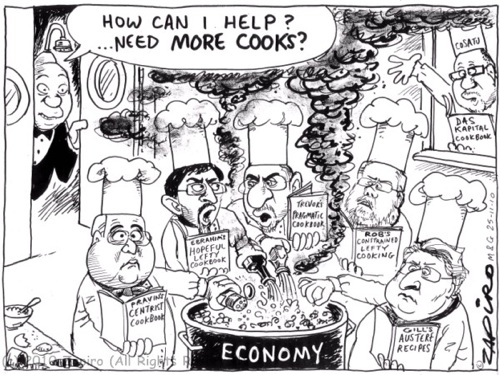They say that to some debates there are no outcomes, merely because the participants love debating that very thing.
The debate on completely free markets (as Von Hayek preferred) and central planning or government intervention (more on Keynes’ doorstep) seems to be one of those (as seen in Commanding Heights). Combining these two policies have been at the order of the day in the developed and now developing world, for quite some time. However, few countries in the world (including South Africa) have refined the art of combining these two effectively, as sound economic policy and political agendas aren’t the best of friends.
I do feel that there is one example in the world that provides a good example of how policies are combined to achieve economic growth: Singapore.
A recent article on Economy Watch provides a good backdrop and forecast to what is currently taking place in Singapore. Human capital, infrastructure and oppennes are powerful drivers in Singapore’s economic growth. There are a couple of main points in the article that are worth mentioning:
- Most of Singapore’s labour force are highly skilled. 0,01% Is in agriculture, around 30% are in industries and more than 67% are in the services sector.
- Government enforces strict policy to ensure a good standard of primary education and consequently Singapore has an unemployment rate of 2%.
- Many of Singapore’s imports are for basic needs as there are almost no natural resources. Other resources are imported, refined and re-exported.
- Singapore is used by many MNC’s as a base to export to other countries, because of its good geographic location. This is a good source of revenue, without raising tariffs.
- In Singapore there is a strong working relationship between the government and the private sector. This facilitates growth, as policies are implemented that promote growth for private business owenrs.
- There are very few barriers to trade in Singapore.
- Initially infant industries were protected with Singapore’s industrialization in the late 1960’s, but this was done effectively.
The lessons to learn from Singapore are simple. As long as these three drivers of economic growth are operating effectively, it doesn’t matter what they are operating in (innovation, industries, services, green energy, etc.). Find what you are good at, and do it well. If you’re looking for economic growth solutions there should be a strong relationship between government policies and private sector needs.Below are three points, each addressing a driver of economic growth and how South Africa fits into the picture.
- A strong focus on education is necessary for a healthy economy. In South Africa poorly paid educators, along with poor educational administration is costing thousands of children a chance to be properly educated. This relates into more unskilled labour, which in turn means more pressure on the low-skilled industries to create more jobs. In this instance, we remain dependant on primary goods for sustaining trade, while unempoyment remains high.
- Investment into infrastructure is critical. This point needs no extensive explanations. Poor infrastructure means education is more difficult, transport becomes more expensive and products’ prices rise. The whole economic cycle is slowed down.
- Open trade policies+informed policy decisions=success! Using its significant geographic location, Singapore opened up its trade policy and its ports became very active. For open trade policy to be effective, the first two criteria needs to be met. Competent personnel, together with effeicient infrastructre can cause S.A. to become a springboard for trade into Africa.
These three criteria are interlinked. High human capital levels will lead to effective infrastructure implementation and that can facilitate an open trade policy. With the economy then growing, there is room for better education, which adds to human capital…and the cycle continues to repeat itself. From the Singapore case it is clear that these three pillars need to be in place to ensure successful and sustained growth.
Policy makers have to start engaging with the private sector, if we want to see sustained growth in South Africa.
4Inmore
J.Malan


Very nice post. Singapore is an interesting example of state-led and private sector driven growth. When you get to the drivers of growth: education, infrastructure, openness, how do you see the roles of the state and private sector? What is the role for private education? Is openness and export orientation a market story or what role is there for incentives or protection of infant industries?
I find this blog very interested, especially Singapore, who would have known that they were so economic successful. With regard to South Africa’s drivers of economic growth,the question need to be raise whether it is a political problem or economic problem that South Africa is facing with over the years, which prevent them to reach these long term economic goals. I think South Africa’s government is not a very successful reformer, who is unable to steer and implement policy changes to fruition despite from economic actors, interest groups and political forces whose interest may be threatened by it. This is mainly as a result of the underlying structural problem South Africa’s government experiencing and its infective networking procedure. This failure to perform at the top level will eventually spill over adequately to different sectors in the economy, such infrastructure development and the efficient operations in the private sector.
theavengersecon
JJ de Villiers (Thor)